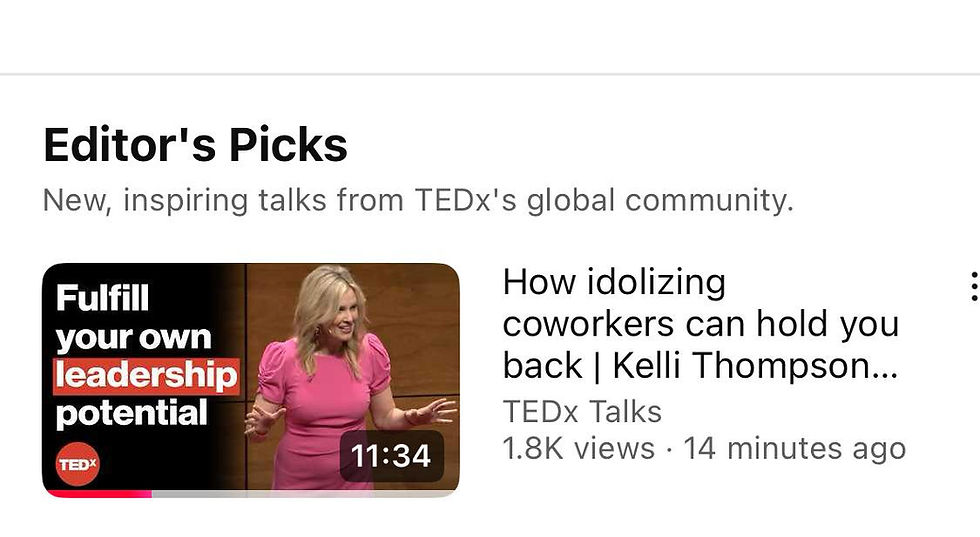How to “re-brand” yourself as a more strategic leader
- Kelli Thompson

- Jul 14
- 4 min read
Updated: Aug 25
One of my clients recently started a new job overseeing a technology function in a professional services and consulting organization. Excited to start her new role, we reviewed her goals as part of the coaching agreement, one of her key priorities was to rebrand herself as a strategic, intentional leader and not a doer.
This goal was important to her because in her past roles, she received consistent feedback that she was too far deep into the work and seen as a high achieving working leader, but not someone who was ready for the executive ranks. She admitted that far too often she was pulled into doing the work and because she loved to feel productive, she jumped in enthusiastically. She wasn't sure how to not be that way and not jump in when asked.
While I've had men and women clients both receive this feedback, it's especially prevalent for women to hear that they “aren't strategic” often times because they are more likely to be volunteered to help others or for non-promotable tasks at work.
Essentially, my client wanted to rebrand herself at work from a high-achieving, indispensable manager to a strategic, intentional leader that was seen as executive material.
In fact, many of my clients have the goal to “rebrand” themselves at work. In my own corporate career, I received some direct feedback early on as to what was keeping me from my own desired promotions. Thus, I had to work intentionally to have people see my in a new way. Even today as my business grows and evolves, there is always an element of little “rebrands” along the way as I grow and the services I offer evolve.
As I wrote in Closing The Confidence Gap, you are always teaching people how to treat you, whether it’s your partner, your kids, your team, or
your colleagues. Say yes to everything or promote yourself as a “tolerator,” people learn they can talk down to you, treat you as a pushover, or take advantage of your generosity. And you’ll keep attracting that into your life.
However, when you stand firm on your leadership values and own your talents and say no to work or situations that don't align with them, people will go elsewhere. Or, with your coaching they will learn how to do the task themselves instead of offloading to you.
🔥 Simply put, “rebranding” yourself as a new kind of leader is just teaching people how to treat you in new ways. It's choosing to respond differently when help is asked for or requests are made for your time and energy.
PUT THIS IDEA INTO ACTION
Teaching people to see you in new ways can be as simple as changing how you respond to people when they reach out to you. Remember that humans love easy habits, so when they find themselves in a pinch or need a quick answer, it's likely their default setting to reach out to you out of comfort.
The best and easiest place to start is to have some simple coaching questions ready when someone reaches out and attempts to pull you back into giving advice, help or getting back into the weeds.
Here are some easy responses to keep on hand and when to use them:
Scenario 1: The “Help Me” Moment
Them: Do you have a minute? How do I do XYZ? (Or, my co-worker is driving me crazy, etc etc)
Instead of jumping in, say this:
This sounds challenging, what have you tried so far?
This is a tough spot/thing, what do you think you might try?
Why this works:
Instead of jumping in and giving solutions, you are encouraging them to think for themselves and handing the problem back so you can focus on higher level work.
Scenario 2: “I'm stuck and don't know” situation
Them: I've tried everything and don't know what to do. I'm really frustrated.
Instead of solving the problem or taking over, ask this:
I hear you. Have you ever encountered a situation like this before? What did you try? Anything you could transfer to this scenario?
I hear you. Do you know of anyone who has had to work through this? How did they handle it? Do any of those approaches feel aligned for you to try?
Why this works:
It can be tempting at this point to take over when things get sticky or you notice discomfort. It can be tempting to ease the discomfort by telling them what you would do. However, by asking people good coaching questions, they learn to grow and solve challenges on their own without needing you all the time so you can be free to work on more strategic challenges.
Scenario 3: Using your new time well
If you need tips on how to spend your newly freed up time and advocate for your ideas, check out THIS FRAMEWORK. Yes, you have to redirect energy while also ensuring that you are valuable AND visible to your colleagues and senior leaders.
Try this next: If you take nothing else from this, try responding with my favorite coaching question whenever anyone comes to to me for advice,
“What's been your current approach?” So many times they talk themselves into their right answer. You just get to hold space and encourage them on.

Kelli Thompson is an award-winning author, keynote speaker, and executive coach who specializes in helping high achievers advance to influential leaders in their organizations. She is the author of the critically acclaimed book, Closing The Confidence Gap: Boost Your Peace, Your Potential & Your Paycheck.
Learn more about: Executive Coaching | Speaking & Training | Group Programs





Comments